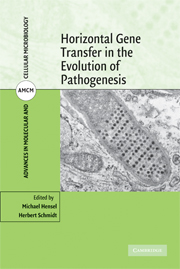Book contents
- Frontmatter
- Contents
- Preface
- Contributors
- PART I Theoretical Considerations on the Evolution of Bacterial Pathogens
- PART II Mobile Genetic Elements in Bacterial Evolution
- 3 Phage-bacterium Co-evolution and Its Implication for Bacterial Pathogenesis
- 4 The Role of Bacteriophages in the Generation and Spread of Bacterial Pathogens
- 5 Genomic Islands in the Bacterial Chromosome – Paradigms of Evolution in Quantum Leaps
- PART III Paradigms of Bacterial Evolution
- PART IV Interkingdom Transfer and Endosymbiosis
- Index
- References
4 - The Role of Bacteriophages in the Generation and Spread of Bacterial Pathogens
from PART II - Mobile Genetic Elements in Bacterial Evolution
Published online by Cambridge University Press: 16 September 2009
- Frontmatter
- Contents
- Preface
- Contributors
- PART I Theoretical Considerations on the Evolution of Bacterial Pathogens
- PART II Mobile Genetic Elements in Bacterial Evolution
- 3 Phage-bacterium Co-evolution and Its Implication for Bacterial Pathogenesis
- 4 The Role of Bacteriophages in the Generation and Spread of Bacterial Pathogens
- 5 Genomic Islands in the Bacterial Chromosome – Paradigms of Evolution in Quantum Leaps
- PART III Paradigms of Bacterial Evolution
- PART IV Interkingdom Transfer and Endosymbiosis
- Index
- References
Summary
INTRODUCTION
It appears that one of the first things that occurred to Felix d'Herelle when he discovered bacteriophages in 1917 was that these mysterious objects might provide a means of killing bacteria that are pathogenic to humans (Summers, 1999). The still ongoing story of phage therapy, as this approach was called, has been told elsewhere and will not be retold here, but it serves to point out that scientists have been interested in the effects of phages on their hosts since their discovery. d'Herelle believed, and eventually established, that phages are viruses that infect bacteria. However, it was not until the experimental investigations of phages at the dawn of molecular biology in the 1940s and 1950s that it became clear that phages - and for that matter their bacterial hosts - are genetic organisms (Luria and Delbrück, 1943; Hershey and Rotman, 1949; Hershey and Chase, 1952; Stent, 1963), just like fruit flies, corn, and humans, and so could be expected to mutate and evolve.
Although some work was done on the evolution of phages in the 1960s, 1970s, and 1980s, a more detailed understanding of the genetic mechanisms of phage evolution had to wait until the advent of high-throughput DNA sequencing in the 1990s. This is because the genetic history of a phage, while it is to a significant extent encoded in the phage's genome sequence, is largely invisible to our analysis until we can compare that sequence to the genome sequences of other phages.
- Type
- Chapter
- Information
- Horizontal Gene Transfer in the Evolution of Pathogenesis , pp. 79 - 112Publisher: Cambridge University PressPrint publication year: 2008
References
- 9
- Cited by

